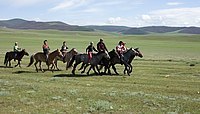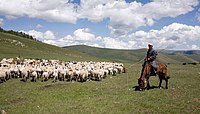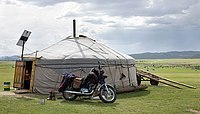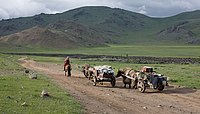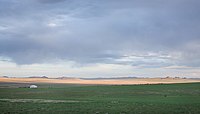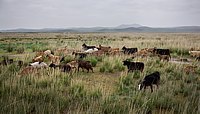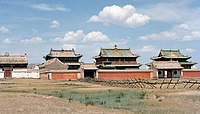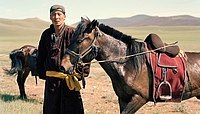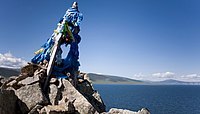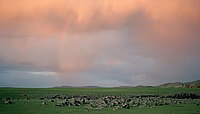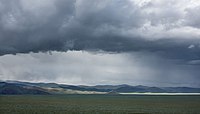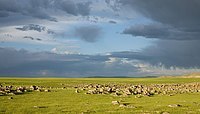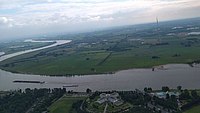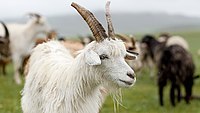A visit to the realm of the Nomads
A vast country: Under a clear, blue sky, the steppe stretches all the way to the horizon. Mongolia’s rolling prairie seems boundless.
What immediately comes to mind is a life on barren ground that is full of privation, a close bond with nature and the spirit of ancient traditions.
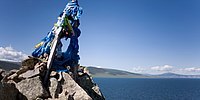
Even though it’s already been a while, Franca Wohlt is not likely to ever forget her visit to Mongolia: 'The beautiful landscape and the incredible freedom that Nomads experience left quite an impression on me. Their independence and freedom is really quite unique'. In 2008, judges of tretford’s photography competition 'Farbe sucht Gesicht' awarded a first place for the work submitted by this Berlin-based photographer. Her prize was a photography trip to Mongolia.
In June of 2008, Following four months of travel preparations, Franca Wohlt and tretford‘s Anne Surlemont landed in the Mongolian capital of Ulan Bator: 'What a startling contrast to what we later saw in the prairies and among the Nomads! Modern buildings – it’s amazing how much construction is going on. As we headed out of the city and into nature, the overall impression I had of Mongolia is that it’s unbelievably beautiful’.
They reached the realm of the Nomads and their animals in an all-terrain vehicle. A Mongolian interpreter, who also cooked and forged contacts for them, accompanied Franca and Anne on their 10-day-long journey. Franca recalls that 'she took us to some families that she knew and introduced us. Back in Germany, I sent her the photos I took of them to pass on to the families as a keepsake. 'Seeing this country and experiencing its people and the goats was a very moving experience for both women that they won’t soon forget'.
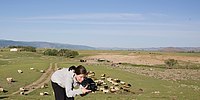
Living with their herd
For Mongolian Nomads their livestock is their life. Horses, yaks, sheep and goats live together in large herds. Franca Wohlt gained some insights into an altogether different living environment: 'The Nomads are very much integrated in the cycle of nature. They get up early with the animals'. At daybreak, the shepherds milk the animals. Indeed, their work changes with the rhythms of the seasons:
In springtime, when the animals shed their fur, Nomads comb out the Cashmere goats’ fine Cashmere wool and cut (rather than shear) their top hair. Franca’s encounters with the Cashmere goats – who were unexpectedly shy and kept at a distance from her and her camera – put Franca Wohlt’s patience to an unexpected test.
Nevertheless, she managed to shoot some very impressive photos. Mongolian wool goats look completely different than the cloven-hooved animals we are familiar with in Europe: They are large animals with magnificent hair and floppy ears. Apart from the highly-prized Cashmere goat hair, they also provide meat, milk, cheese and fat – important staples for the inhabitants of Mongolia.
For more information about the photographer please go to: www.franca-wohlt.de
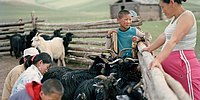
Out and about with goats and yaks
More than a third of Mongolia’s population lives as Nomads. They are among the last of the indigenous peoples and they spend the entire year in the open air. Their main focus is on their herd because this is their only means of sustenance. And this goes hand in hand with a deeply-felt reverence for their animals. Nomads deposit the skulls of deceased animals that were especially close to their heart in special spots. 'Individual animals are esteemed and appreciated like a family member or friend'.
Their large tents – or yurts – which are fashioned out of several layers of cotton, wool felt and canvas serve as their houses; each one offers room for an entire family. As a welcome gesture, we were given cups of tea containing a piece of butter and salt. 'It tastes a bit like thin broth. I enjoyed it because it was so nourishing. And it felt good to have a hot beverage'.
Orange and blue – the colours of their religions
It’s warm and colourful inside a yurt; Orange is a popular colour within the Buddhist cultural circle. Also noteworthy are the so-called 'ovoo', teepee-like wood constructions on piles of stones that are wrapped in blue prayer flags. 'You can buy them in the city or at monasteries; leaving them there brings good luck and a safe journey. If you chance upon such a rock pile, you have to drive around it a few times. Or get out of your car, take a rock and place it on top; then walk around the pile of rocks several times'. Ovoos and sacrificial trees, which are also wrapped in cloths, originate in shamanic culture and traditions, which coexist with Buddhism.
Cold winters, hot summers
During each summer, Nomads are forced to relocate – with the family, herd and yurt – up to four times to allow the grass to recover: A yurt is quickly dismantled and setup. Yaks pull the heavy carts for families that don’t own a truck. During these few months, temperatures can reach up to 30 degrees Celsius and life takes place outdoors. In contrast to this, winters are long and hard with temperatures dipping as low as minus 40 degrees. Both man and beast must bear these extreme conditions. During the cold season, Nomads live in their yurts while the animals remain outside. A stove in the middle of the yurt serves as both heater and as a burner for cooking.
In spite of their hard work and harsh weather conditions, Nomads are friendly and hospitable people who love to communicate and laugh. Franca Wohlt: 'I asked one of the women if her life was full of hardships. It surprised me when she suggested that it’s just as hard to live in the city, if not harder'.

